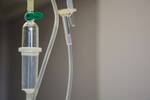There are a number of different causes for thrombocytopenia, which means that there is a (too) low platelet count in the blood (thrombocyte = platelet, penia = shortage). A low platelet count can be caused by either: too high a consumption of platelets (due to extensive damage of all the small vessels of internal organs, e.g. in case of severe infections/sepsis) too much breakdown of platelets (as is the case in ITP).
The blood clotting problems caused by thrombocytopenia are mainly reflected in the occurrence of large subcutaneous haemorrhages (haematomas) and small pinpoint haemorrhages in the skin (petechiae), or by mucosal haemorrhages (especially nose and gum haemorrhages). In severe thrombocytopenia, bleeding may occur in the gastrointestinal tract or the urinary tract; cerebral haemorrhage is rare.
Thrombocytopenia caused by an increased breakdown of platelets is known by several different names, such as Werlhof's disease (named after the discoverer of the disease in 1735), Idiopathic Thrombocytopenic Purpura (ITP) or Auto-Immune Thrombocytopenic Purpura (AITP). The name Immune Thrombocytopenia (still abbreviated ITP) has been the agreed term for a number of years.
The term previously used, Idiopathic Thrombocytopenic Purpura, actually means: bruises (purpura) due to a platelet deficiency (thrombocytopenia) without a clear cause (idiopathic).
This name dates back to the time when there were no tests available to determine the cause. It was later discovered that the majority of ITP patients have antibodies in their blood that are directed against their own platelets. Antibodies are proteins in the blood that play an important role in the defence against infections. The antibodies attach themselves to a foreign invader and cause it to break down. In autoimmune diseases, antibodies are present in the blood which are mistakenly directed against the body's own cells.
In ITP patients, these auto-antibodies are directed against proteins on the platelet wall. The faulty binding of the antibodies to the body's own platelets accelerates the breakdown of the platelets. This breakdown mainly takes place in the spleen, but a significant amount of breakdown can also take place in the liver.
AITP would actually be a more accurate name for this disorder, but for the sake of convenience we will stick with ITP. It is largely unclear exactly why these auto-antibodies are formed. It seems to be caused partly by a derailment of the immune system (an auto-immune disease) and partly (especially in young children) there may be cross-reactivity. Some parts of viruses or bacteria resemble the structures of platelets, so the antibodies bind not only to the viruses or bacteria but also to the platelets. This means ITP can sometimes occur following an infection.
ITP is classified as:
• Newly diagnosed ITP < 3 months
• Persistent ITP 3-12 months
• Chronic ITP > 12 months
In young children, ITP occurs suddenly and is therefore traditionally called acute ITP. The acute form, by definition, lasts less than 12 months. It occurs mainly in children between the ages of 2 and 8 years and is, in most cases, short-lived. It is equally common in both boys and girls. It often occurs in previously healthy children who present with the sudden appearance of bruises and/or nosebleeds after an infection. Sometimes, the acute form can develop into the chronic form.
Chronic ITP occurs mainly in adults. As with most autoimmune disorders, it occurs more frequently in women than in men. 30 percent of chronic ITP patients already have another autoimmune disorder, such as thyroid disease, rheumatism or Systemic Lupus Erythematosus (SLE).
The severity of ITP is determined only partly by the platelet count. Severity can be classified according to the intensity of the bleeding tendency present

In patients with isolated ITP, severe bleeding is generally only seen if the platelet count is less than 10 million per millilitre of blood. This can vary in patients with multiple (autoimmune) disorders.
Less severe symptoms (dry purpura):
Severe symptoms (wet purpura):
Physical examination:
In addition to any bleeding symptoms, an enlarged spleen or an enlarged liver is sometimes present.
Tel. 085-1303570 | E‑mail info@itp‑pv.nl | Bank 1 NL69RABO0345603702 | BIC RABONL2U |Bank 2 NL91ABNA0401810461 | BIC ABNANL2A | KvK 17156005 | ANBI 8135.93.372


